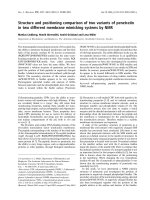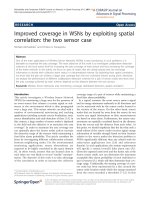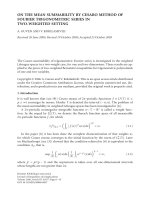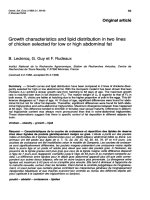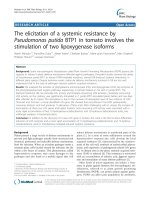Bilingual by choice raising kids in two (or more) languages
Bạn đang xem bản rút gọn của tài liệu. Xem và tải ngay bản đầy đủ của tài liệu tại đây (1.63 MB, 225 trang )
Bilingual
By Choice
Raising Kids in Two
(or more!) Languages
Bilingual
By Choice
Raising Kids in Two
(or more!) Languages
Virginie Raguenaud
First published by Nicholas Brealey Publishing in 2009.
Nicholas Brealey Publishing
20 Park Plaza, Suite 1115A
Boston, MA 02116, USA
Tel: + 617-523-3801
Fax: + 617-523-3708
Nicholas Brealey Publishing
3-5 Spafield Street, Clerkenwell
London, EC1R 4QB, UK
Tel: +44-(0)-207-239-0360
Fax: +44-(0)-207-239-0370
www.nicholasbrealey.com
© 2009 by Virginie Raguenaud
All rights reserved. No part of this publication may be reproduced in any manner
whatsoever without written permission from the publisher, except in the case of
brief quotations embodied in critical articles or reviews.
Printed in the United States of America
13 12 11 10 09 1 2 3 4 5
ISBN: 978-1-85788-526-2
Library of Congress Cataloging-in-Publication Data
Raguenaud, Virginie.
Bilingual by choice : raising kids in two (or more!) languages / by
Virginie Raguenaud.
p. cm.
ISBN 978-1-85788-526-2
1. Bilingualism in children. 2. Language acquisition. 3. Multilingualism
in children. 4. Child rearing. 5. Child development. I. Title.
P115.2.R34 2009
404'.2083—dc22
2009033076
To my parents, Suzy and Jean-Pierre Raguenaud,
for packing up and crossing cultures with three teenagers in tow.
To my daughters Natasha and Sofiya, and my husband Vern,
for continuing this bilingual, nomadic journey with me.
CONTENTS
ACKNOWLEDGMENTS
xi
FOREWORD
xiii
INTRODUCTION
CHAPTER 1
CHAPTER 2
CHAPTER 3
xv
Getting Past the Misconceptions
About Bilingualism
1
A Conscious Choice
Language Delay
Semilingualism
Language Overload
Special Needs
Taking Charge
1
4
8
11
13
16
The Logistics of Raising Bilingual
Children
19
Defining Your Goals
Language Strategies
When Children Mix Languages
Learning to Read
19
21
24
26
Keep Talking From Day One
Strategies in Public
Staying Flexible but Committed
29
31
35
Introducing a Second Language
to a School-Age Child
37
Transferring Skills from One Language to Another
ESL Classes
Unexpected Factors that Influence the
Learning Curve
vii
41
42
44
Bilingual By Choice
CHAPTER 4
CHAPTER 5
CHAPTER 6
Helping Our Children Integrate
Maintaining and Progressing in the First Language
Peers
Working Together
45
48
51
53
Challenges at Home
55
When Cultures Collide
All in the Family
Setbacks
Creating a Bilingual Home
55
60
68
73
Schooling Options
79
Homeschooling
Dual-Language Programs
Developmental Bilingual Education Programs
Heritage Language Schools
Charter Schools
Attending School in the Home Country
79
81
83
85
87
88
Bilingual and Recommended for
English Honors
91
The Cost of Losing a Heritage Language
The Importance of Parent/Teacher Conferences
The Future of our Native Languages
Promising Changes
CHAPTER 7
92
97
100
103
The Benefits of Bilingualism (for extra
motivation on days when the Englishonly movement doesn’t sound so
unreasonable!)
109
Bonding as a Family
Academic Skills
Higher SAT Scores
Access to More Knowledge
Self-Esteem
viii
110
111
112
113
113
Raising Kids in Two (or more!) Languages
CHAPTER 8
CHAPTER 9
A Balanced Cultural Identity
Global-Mindedness
College Preparation
Competitive Advantages in the Workplace
Intercultural Awareness
114
114
115
116
119
Listen Up!—Helpful Insights from
Experts in Childhood Bilingualism
and Second Language Acquisition
and Encouraging Advice from
Fellow Parents
121
From Puppet Shows to Bilingual
Scrabble: 50 Activities to Enjoy with
Your Kids at Home
137
Online Activities
153
CHAPTER 10 From Bilingual Storytime to Kids’
Language Clubs: 50 Activities in Your
Local Community
ix
157
ACKNOWLEDGMENTS
T
he idea for this book came during my first presentation at the
2007 Families in Global Transition conference. Many of the
parents I met were struggling to keep their school-age children bilingual and looking for solutions. With her enthusiasm and confidence
in me, Ruth Van Reken encouraged me to put together a proposal and
generously opened the door at Nicholas Brealey Publishing and for
that I’m very grateful.
It is daunting to write a book (with three-year old twins at home!)
but I could not have had a kinder team to work with. It started with
a memorable meeting in Boston with former publisher Patricia
O’Hare, Chuck Dresner, and Jennifer Olsen at the onset of a December blizzard. Although it took me six hours to get home on the bus
(usually a one-hr. ride!), I still had a huge grin on my face when I
finally walked through the door!
Once I finished writing the original manuscript, I worked with
two wonderful editors, Wendy Lazear and Kitty Colton, who helped
me transform my “stream of consciousness” into a well-organized,
easy-to-read manuscript. Thank you, thank you!
To my editor Erika Heilman, I’m grateful for your commitment
to this project and your guidance throughout the editorial process.
I also want to thank Nicholas Brealey for ultimately taking a
chance on a first-time author.
Although the writing process is fairly lonely, I was inspired by the
xi
Bilingual By Choice
great work and brilliant minds of Colin Baker, Francois Grosjean,
Ellen Bialystok, Fred Genesee, Jim Cummins, Stephen Krasner, Donaldo Macedo, and Ofelia García. Thank you for your commitment to
the education of our budding bilingual children.
I’m grateful to all the parents who took the time to answer my
questionnaire and who contributed their inspiring stories in personal
interviews. To my family and friends, local and global, thanks for your
support and insights during the writing process. Finally, I want to
thank my husband Vern for the exciting travel adventures during the
last seventeen years, for your love and patience, and for supporting me
in raising our girls in two (or three!) languages.
xii
FOREWORD
B
ilingualism and bi-literacy are admirable goals for every individual. At the National Association for Bilingual Education
(NABE), we embrace this mantra and advocate learning more than
one language and culture. We are now a global society and we must
learn to create unity within diversity.
As tireless advocates who work to influence and create moreinclusive language policies, more bilingual programs, and better
teacher training, we know that we are investing in our children’s education, our nation’s leadership, and our world’s well-being. By using
our native and second languages in everyday life, we develop intercultural understanding and show, by example, that we respect and can
effectively cross cultural and linguistic borders.
Minority language groups are often identified with relatively high
unemployment, low pay, poverty, and powerlessness. However, local
economies, working with community initiatives, can support and sustain minority languages. Bilingualism is valuable to all as it promotes
cultural understanding and gives a competitive edge in an increasing
number of vocations. Supporting our native languages is always a
good investment!
With this in mind, NABE recommends Bilingual by Choice
because it is aligned with our mission to mobilize parents and communities to support the education of bilingual and English language
learners. As Virginie Raguenaud writes in this book, bilingual children
xiii
Bilingual By Choice
gain intercultural awareness and learn early on that the world is not
defined in the same way by other cultural groups. By teaching our
children to speak another language and to understand another culture, we are creating a more cooperative generation.
Bilingual By Choice offers crucial information to help parents
overcome today’s challenges in raising and educating bilingual children. Together, we need to cultivate a multilingual, multicultural society by supporting and promoting policies, programs, pedagogy, and
research that yield academic success, value native language, lead to
English proficiency, and respect cultural and linguistic diversity.
This practical book offers important strategies that can be implemented right away by parents to make sure that their children become
active and contributing participants in this world. It explains the benefits of bilingualism, shows parents how to raise and keep their children
bilingual, addresses the cultural challenges at home, and helps parents
commit to bi-literacy to ensure their children’s academic success.
As former NABE parent representative and Vice-President, I
encourage parents and educators to read Bilingual By Choice and to
experience all the positive effects bilingualism offers to our world
today.
Rossana Ramírez-Boyd, Ph. D.
Parent Representative 2001–2003
former Vice-President 2008–2009, National Association for Bilingual
Education
xiv
INTRODUCTION
A
shift is happening right now. Powerful institutions are coming
to realize that people who speak a second language, and understand different cultural nuances, make great contributions to this
country in national security, diplomacy, international business, health
care, the arts, education, tourism, and many other areas.
This shift in perception is going to help us as we commit to raising our children with two languages. It will mean more support from
our schools and our communities as we help our children sustain
their first language and excel in English. But our children’s bilingual
future—with all its life-changing social, academic, and economic
benefits—will require a high level of commitment and creativity on
our part. We still need to expose many misconceptions about childhood bilingualism and second-language acquisition.
In a recent interview, linguist and Professor Emeritus at the University of Southern California, Dr. Stephen Krashen said, “Bilingualism in the U.S. only has a future if it is explained to the public and the
research becomes well known.” When I started my master’s in intercultural relations, I came across extensive research on the identity
development of bicultural and bilingual children that finally gave me
a clearer picture of what I had lived through as a twelve-year-old newcomer from France.
xv
Bilingual By Choice
But I also realized that this valuable information rarely leaves academic circles and rarely reaches the people who, like me, desperately
need it to make sense of their uprooted childhoods.
This book is my attempt to share the knowledge. As you follow
the text, you will see that my bicultural identity shows up regularly.
The French side of me likes to listen to the experts and quietly take
notes. I get inspired by their efforts to advance the cause of bilingual
children. The American side of me likes to engage in a more spirited
form of learning: honest insights from parents, who can expose all the
complexities—and sometimes frustrations—of raising bilingual children. In the mix, I have also added my own narrative of my relocation
to the U.S. and how my mother—born and raised in Belgium—and
my father—born and raised in Madagascar—succeeded in raising
three “late” bilingual and multicultural daughters.
When I decided to raise my twin daughters, Natasha and Sofiya,
bilingually, I came across several books that focused on the logistics of
creating a bilingual environment at home: Who will speak what language? How much exposure will the children get? But my conversations with other parents made me realize that we had to take it a step
further, looking deeply at the obstacles and finding out why certain
families were successful at raising bilingual children and why many
failed.
I also wanted to explore the cultural issues in our lives that cannot be ignored. For most of us, bilingualism is not just about raising
children to speak two languages. It’s also about raising bicultural children who learn early on that there are different ways to see the world
and different perspectives about what’s right and wrong; children who
come to know that our truths are just that—ours. Bicultural children
gain intercultural awareness and learn early on that the world as they
know it is not being defined in the same ways by other cultural groups.
By teaching our children to speak another language and to understand another culture, we’re creating a smarter and more cooperative
generation.
xvi
Raising Kids in Two (or more!) Languages
The subject of bilingualism in this country, unfortunately, often
turns into a political discussion of race and power because not everyone is given access to the resources needed to excel in two languages.
In some circles the push for bilingualism is also grossly misinterpreted as immigrants’ desire to to sustain their first language at the
expense of English. That’s not the case. Immigrants are learning English much faster than their predecessors because they understand that
it leads to extraordinary opportunities. However, many of us also
know that if our children acquire our native language, in addition to
learning English, they will have a brighter future.
Although more than 54 million of us speak a language other than
English at home, this country is still defined as monolingual. That’s
puzzling, since even our Founding Fathers were multilingual! Benjamin Franklin spoke six languages, including English, French, Spanish, German, Italian, and Latin. Thomas Jefferson could read Greek,
Latin, French, Spanish, and Italian. He often wrote to friends about
the importance of speaking foreign languages to better connect with
the rest of the world—a message we should all pass on to our children.
The reality today is that this country needs well-educated bilingual and biliterate Americans in almost every field, at the national,
state, and local levels—from the National Security Agency, recruiting
individuals with language skills in Arabic, Chinese, Dari, Farsi, Pashtu,
Russian, Sub-Saharan African, Turkish, and Urdu, to our public
schools, which face a critical shortage of qualified bilingual teachers.
If there’s a time to give bilingualism a future, it’s now. Like it or not,
globalization is here to stay; we might as well make it work for us!
xvii
CHAPTER 1
Getting Past the
Misconceptions About
Bilingualism
Ethnic and national conflicts are most often precipitated
when nation-states ignore demands for greater cultural
and linguistic democracy, not—as is commonly assumed—
when they accommodate them.
Stephen May, author of Language and Minority Rights
A Conscious Choice
As a bilingual mom-to-be, I was curious to see which language would
feel most natural when I first met my twin girls. Although I associate
French with family and nurturing, English has been my community
language for the last twenty-seven years. I’ve spoken English in my
graduate studies, my work, and my twelve-year marriage. For some
bilingual parents, the language choice is not always obvious and
1
Bilingual By Choice
sometimes only reveals itself the first time we hold our children. On our
first day together in the hospital, the girls and I found ourselves bonding in French, and we’ve continued to do so ever since. I have to say,
speaking French in the delivery room felt especially sweet and intimate
with a nine-member crew of doctors, nurses, and an anesthesiologist
working around us! (Twin deliveries create quite a commotion!)
Raising a bilingual child—either from birth or after relocation—
is a necessity for many parents. We want to keep family ties intact
and share our cultural selves with our children. However, as parents
we have to make a conscious choice to keep our children bilingual. It’s
a common misconception that children will simply pick up languages
if they’re exposed to them. It takes commitment and creativity at
home and in our communities for children to learn and, more importantly, maintain two languages. Which is probably why we all know at
least one adult who’s expressed regret at having lost a parent’s native
language. I believe we can succeed if we pay attention to the research,
if we listen to the insights of successful bilingual adults, and if we
learn as a family to mindfully integrate our native language and our
cultural traditions in our daily lives.
EARLY SKILLS
To start, the research reminds us that learning two languages from
birth is as natural as hearing and speaking only one language. McGill
University Professor Fred Genesee, a well-respected scholar in childhood bilingualism, found that infants are able to discriminate between
the sounds of two languages from a very early age, months before
they can produce any sounds. Studies show that even the babbling of
infants is language specific. (1) An infant with a Spanish father and an
English-speaking mother will use Spanish sounds with his father and
English sounds with his mother.
Research shows that the ability to hear different phonetic pronunciations is sharpest before the age of three. (2) Infants and toddlers
2
Raising Kids in Two (or more!) Languages
can differentiate a wider variety of language sounds than older children. Under normal circumstances, children who are exposed to
two languages from birth will learn to speak them with a native accent.
Although everyone, at any age, should be encouraged to learn a second language, the biggest difference between children’s and adult’s
bilingual development will be the ability to develop native-like
pronunciation.
Another early benefit is the development of metalinguistic awareness as children learn to differentiate early on the two language systems used and understand that there are two (or more) words to name
one particular object. (3) Before their second birthday, Natasha and
Sofiya made the connection that French and English represented two
separate languages.
As I sat Natasha down one day in her highchair and wrapped the
belt around her waist, she looked at me and said, “Papa says seatbelt
. . . Maman dit ceinture.” Even though I’m not a linguist, I could feel
at that moment that something amazing was happening in her brain
as she reflected on our home’s language mix. Out of curiosity I
quizzed her further and asked what she said. Natasha without hesitation replied “Belt!” while Sofiya smiled at me and said, “Ceinture,
Maman.” (They like to contradict one another, so with twins I’m
guaranteed at least one answer in French!)
According to well-known Canadian scholar Ellen Bialystok,
author of Language Processing in Bilingual Children, this ability to
reflect on language as a system is “a crucial component of cognitive
development because of its documented relation to language ability,
symbolic development, and literacy skills.” This awareness often leads
to a stronger appreciation for reading. (4) Children who are exposed
to two languages learn to think about language and analyze it, the
way travelers to another country start to think about their own behaviors and assumptions. This flexibility and creativity show up in clever
ways as our children learn to speak and strengthen their budding
bilingual cognitive skills. In these captivating early stages of language
3
Bilingual By Choice
development, we’re witnessing what will soon be an exceptional language repertoire that will give them unique ways to express themselves and better communicate with the world around them.
Unfortunately, personal language choices and the benefits of early
bilingualism are often overshadowed by negative misconceptions generated in the media, in schools, and in communities at large. It’s impossible to discuss bilingualism in the U.S. without encountering fear,
ignorance, and prejudice. It’s important for parents who are reluctant
to raise their children with two languages to understand the ways in
which certain aspects of childhood bilingualism are misinterpreted or
exaggerated. We must also be aware that our own attitudes and beliefs
play a crucial role in helping our children sustain their languages as
they grow. For example, if a parent has been made to believe that his
native language is less relevant than English, his child will soon believe
that message as well.
To make sure that our children reap all the lifelong cultural,
social, and economic benefits of speaking two languages, let’s look at
how scientific research objectively dispels the most common misconceptions of early bilingualism.
Language Delay
Not all children develop language at the same rate—a fact that sometimes confuses parents who relate language delay to their bilingual
choice. In our personal experience there was a wide gap between
Natasha’s and Sofiya’s language development. Natasha spoke twoand three-word combinations well before her second birthday, while
Sofiya developed other skills and began two- and three-word combinations at around two-and-a-half years old. At first, we wondered
why Sofiya wasn’t speaking as much as her sister. But we noticed that
she was making progress nonetheless, adding new words to her vocab-
4
Raising Kids in Two (or more!) Languages
ulary and following directions, so we decided to focus on what she was
accomplishing in her own right instead of comparing her to her sister. Once we had made the decision to raise our girls bilingually—to
understand different perspectives, to communicate and think
creatively in two languages, to connect with people from diverse
backgrounds—it seemed trivial to worry about whether they said their
first words at 9 months or at 15 months!
When you read about language-delay issues from parents from
different cultures, it soon becomes obvious that everyone—family,
neighbors, pediatricians—bases their comments on cultural values
that represent only one perspective. In her book How Language Comes
to Children, psycholinguist Benedicte de Boysson-Bardies explains that,
in general, “American mothers encourage their child to talk and, above
all, to name . . . . while French mothers do not watch for linguistic
performances, feeling instead that the child ought to be happy and
well behaved and should play a great deal.” She adds, “Thus, too, German mothers expect their children to speak later than do Costa Rican
mothers.” (5) Of course these are generalizations but they point to the
central role culture plays in children’s language development. Parents
around the world obviously have different expectations for their
children.
Because of the emphasis in our U.S. culture on “doing everything
early,” the term language delay is often misunderstood. There is such
a wide time frame for reaching each language milestone that parents
unwillingly find themselves comparing their children’s development
with other children around them. Even with the best intentions, it’s
difficult not to! However, according to the American SpeechLanguage-Hearing Association, only three to ten percent of children
will experience language delays. (6) Here are the association’s general
guidelines for parents raising bilingual children: “Like other children,
most bilingual children speak their first words by the time they are one
year old (e.g., “mama” or “dada”). By age two, most bilingual children
5
Bilingual By Choice
can use two-word phrases (e.g., “my ball” or “no juice”). These are the
same language developmental milestones seen in children who learn
only one language.” (7) Most speech pathologists and pediatricians
agree that parents should watch for the more serious symptoms to
keep things in perspective. They include:
•
•
•
•
•
not babbling by 12 to 15 months
not understanding simple commands by 18 months
not talking by the age of two
not using sentences by the age of three
not being able to tell a simple story by the age of four or five (8)
In 2002, cognitive neuroscientist Laura-Ann Petitto and her colleague Ioulia Kovelman looked at different stages of brain development and matched them with four different time frames of bilingual
language exposure. They concluded that early and extensive exposure
to a second language is beneficial for brain development. According
to Petitto, “This will occur without any of the dreaded ‘language contamination’ often attributed to early bilingual exposure.” (9)
Although it often is the most pressing issue for new parents raising bilingual children, there is simply no scientific data that proves
that hearing and speaking two languages from birth will cause a language delay. As the American Speech-Language-Hearing Association
stipulates, “Children all over the world learn more than one language
without developing speech or language problems. Bilingual children
develop language skills just as other children do.” (10)
ENOUGH LANGUAGE EXPOSURE?
Language delay may occur, however, if a child has sparse exposure to
one of his languages. For example, if the parent who speaks the home
language is also away at work most often, it will take much family
and community support and resources to make sure the child hears
6

